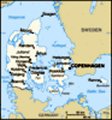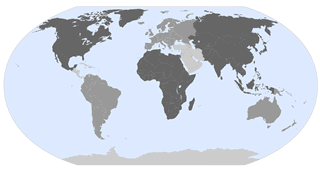Advertisement
Published: June 10th 2015
Copenhagen, Denmark--Tuesday, June 3
rd After Valerie took some pictures of the Langelinie port and the pier this morning, we caught a shuttle bus into downtown Copenhagen. The shuttle drove from the wharf area past new housing, various buildings, a large park, a Museum under repairs and then into the main part of the City. It let us off on a street that runs between the Tivoli Gardens and the ornate multi-towered City Hall.
We crossed the road keeping a careful eye out for the multitude of bikers , and onto the plaza in front of it, known as City Hall Square. The square was filled with statues and a very interesting fountain. One statue on the side of the plaza is of Hans Christian Anderson and looks toward the Tivoli Gardens. A group of Asian tourist mobbed it while Valerie was taking pictures.
We climbed the steps into the building and went into a small side room that housed Jen Olsen’s World Clock in it. Across the hall was a room used for the office and tiny gift shop. The huge center hall was lovely and
had a display of photographs taken during WWII about the Danish Resistance. It debunked several myths about the Danish Jews and the German occupation---for example, the King and Queen never wore a Star of David on their clothes as was required by the Hitler for the Jews. We found the exhibit very interesting and informative.
The decorations on both the outside and inside of this building were lovely—A richly-decorated front with a gilded statue of Absalon; a tall, 105 meter, slim clock tower; gold and painted carved frescos over the doors; tiles of birds, the sea, and other elements of Denmark painted tiles inside the arches that were especially well-done and beautiful.
Across the street, and all along the downtown main street, was the construction mess from building an underground subway system. We walked around the block looking at the stores, statues, and other interesting buildings. We went into several stores looking for diet coke and some snacks, but found the prices to be very high—higher than they charge onboard ship. We then walked down to the front of the Tivoli Gardens and looked inside the metal fence. It wouldn’t open for a while and if we understood
the pricing, the admission price was too high for the time we had left to explore it. They did advertise a number of plays and entertainment as well as the amusement section with its rides. So, we then walked back to the bus stop, boarded the waiting bus, and headed back to the port, passing the large railroad station and other government buildings on the way.
Once back where the ship was docked, we walked down along the waterfront park and promenade to look for the statue of the Little Mermaid. We passed a number of statues, the Langelinie Marina, a large Angel topped monument that seemed to be for men lost at sea, but there was no signage to tell us what it stood for, and a number of large blooming wild rose shrubs that were full of small sparrow-like birds. Seen out in the water, were the Royal Yacht and various boats you could hire to take you on a tour.
The Little Mermaid, the iconic statue of Copenhagen, was given to the city in 1913. The small bronze sits on some rocks a few feet into the water from the shore. I believe because of
this placement, she has had a rough life. This statue has been damaged and defaced many times since the mid-1960s for various reasons, but has been restored each time. In 1964, the statue's head was sawn off and stolen by politically-oriented artists. Her head was never recovered and a new head was produced and placed on her body. In 1984, her right arm was sawn off; in 1990, an attempt to sever the statue's head left a deep cut in the neck; in 1998, the statue was decapitated again; in 2003, the statue was knocked off its base with explosives and later found in the harbor’s waters. In 2004 and 2007, the statue was draped in a burqa in a protest against Turkey joining the European Union. Paint has been poured on the statue several times, once in 1963 and twice in 2007.
Back on board ship, we had lunch and then got ready for our bus tour. Once we cleared the port area, the driver took us through an historic district called Nyboder, built by Christian IV, which he started in 1631 as housing for the Royal Danish Navy. All the row-house type units are painted a bright
yellow ocher color and are now open to all military families as well as the general public. The red brick St Paul’s Church, 1877, is located in the middle of this Nyboder area and is often referred as to Nyboder’s Church.
Really raining now. Our first stop was at Rosenborg Castle. This Castle goes back to 1606-1607, when King Christian IV had a summer house built in a newly laid out park, “The King's Garden.” The castle was one of his many building projects and is built in the special Dutch Renaissance style, which became typical of Danish buildings during this period. Originally, it was built to a fairly simple plan, but was expanded again and again. It was used as a Royal residence until around 1710, when Christian IV's great grandson, Frederik IV, left it in favor of more up-to-date, summer residences.
Rosenborg Castle then became the place to house the Royal collections, including the crown jewels, as well as, a magnificent collection of riding trappings and parade arms, plus costumes, heirlooms, and precious artifacts. Collections of glass and porcelain are stored here, as well as the art collections captured from various wars.
Many of the
well-preserved rooms are quite unique, as they were basically “frozen” in time, not having been lived in since the 1700’s. One of the more interesting rooms was the grand hall, where the thrones were set upon a dais and were guarded by three life-size silver lions made between1665-1670. The walls in this room are covered by floor-to-ceiling fine tapestries. Several other rooms were covered wall-to-wall and floor-to-ceiling with framed oil paintings. Some of the original lovely garden could be seen as we hastily dashed through the rain, and made our way back to the waiting bus. If you want more information on this really interesting Castle go to:
http://dkks.dk/visit-us/.
The driver then drove us by the Amalienborg Palace where the King and Queen live today. This Palace faces the water and the Royal Yacht and a “room” to wait in while boarding the Yacht was on the other side of the road from the entrance to the Royal Palace. Also on the water side of the road was a pretty water feature/fountain.
We crossed at the end of the Nyhavn or new harbor that was the 17
th century waterfront, and now, an entertainment district with its brightly painted
townhouses lining both sides of the canal. Hans Christian Anderson lived here for about 18 years. It became obsolete with the large size of the newer ships which were unable to navigate into the small harbor and was then used for small vessel freight traffic until after WWII.
We headed toward Christiansborg Palace that houses the Parliament, the office of the Prime Minister, and the Supreme Court. Several rooms, including the Royal Reception Rooms and the Palace Chapel are used for various ceremonies. The Royal Stables are also located on the grounds of this Palace.
To get to the Royal Reception Rooms, we first entered through the Queen's Gate, and then climbed up the King's Stairway and then put on the usual paper/plastic booties. We then toured the library, the throne room with its lovely parquet floors, the dining room (we didn’t count the number of chairs), and finished off with the 40 meter long Great Hall that seats 400 for state dinners.
The Great Hall was renovated on the occasion of Queen Margrethe II's 60th birthday when artist Bjorn Norgaard’s 17 tapestries, recounting the history of Denmark, were hung on the walls. The tapestries were a
gift from the Danish business community on the occasion of her 50th birthday. I am not sure I liked these modern tapestries, but they were VERY colorful and extremely interesting to look at.
From the window we could see the show grounds that are part of the Royal Stables where the horses and carriages are housed. This area also has a riding school, used to exercise the 20 horses now stabled here, which is significantly less than the peak number of 270 horses.
We could also see the Holmen Lutheran Church across the road that was pointed out to us by our guide. It is famous for having hosted the wedding between Margrethe II, current queen of Denmark, and Prince Henrik in 1967. It is also the church that was most recently in the news, as it was the site of the baptism of their twin grandchildren in 2011.
Back to the ship, dinner and collapse, after an extremely full day!! Lovely city!
Advertisement
Tot: 0.071s; Tpl: 0.016s; cc: 12; qc: 24; dbt: 0.0346s; 1; m:domysql w:travelblog (10.17.0.13); sld: 1;
; mem: 1.1mb
























